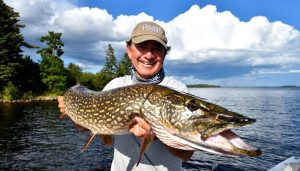Pike fishing is an exhilarating experience, offering the chance to catch one of freshwater’s most formidable predators. Known for their sharp teeth and aggressive strikes, pike can be challenging yet rewarding to catch. Whether you’re a beginner or looking to improve your skills, here are ten things you need to know before going pike fishing.
1. Understand Pike Behavior
Pike are ambush predators, often lurking in weedy areas, near drop-offs, or along the edges of reed beds. Understanding their behavior will help you locate them more effectively. Pike prefer cooler waters and are more active during the early morning or late evening, especially in warmer months.
2. Use the Right Gear
Pike have sharp teeth and powerful jaws, so it’s essential to use sturdy gear. A medium to heavy-action rod paired with a high-quality reel and braided line is recommended. Braided line offers the strength needed to handle pike without risking a break-off during the fight.
3. Select Appropriate Lures
Pike are attracted to flashy and noisy lures that mimic the movement of prey. Spinnerbaits, jerkbaits, and large spoons are popular choices. Consider the water conditions when selecting a lure—bright colors work well in murky water, while natural patterns are effective in clear water.
4. Don’t Forget a Wire Leader
A wire leader is crucial when fishing for pike due to their sharp teeth, which can easily cut through regular fishing line. A wire leader of 12 to 18 inches will protect your line from being severed, ensuring you can reel in your catch without any surprises.
5. Check Local Regulations
Before heading out, make sure to check the local fishing regulations for the area. Regulations may include specific seasons for pike fishing, size limits, and catch-and-release requirements. Following these rules helps conserve pike populations and ensures sustainable fishing.

6. Learn the Best Fishing Techniques
Several techniques are effective for pike fishing, including casting, trolling, and fly fishing. Casting near weed beds or submerged structures can yield great results, while trolling allows you to cover more water and find active fish. Fly fishing for pike is also gaining popularity, offering a unique challenge.
7. Be Prepared for the Fight
Pike are known for their strong, acrobatic fights. When you hook a pike, be prepared for sudden runs and head shakes. Keep steady pressure on the fish, and avoid jerking the rod, as this can result in a lost catch. Patience and control are key to landing a pike successfully.
8. Practice Safe Handling
When handling a pike, be cautious of their sharp teeth and gill plates. Always use a pair of long-nose pliers to remove the hook, and consider using a landing net to safely secure the fish. Holding a pike by the gill cover is a common method, but make sure to support the fish’s body to prevent injury.
9. Know the Best Seasons
Pike fishing can be successful year-round, but spring and fall are particularly productive. In spring, pike move into shallower waters to spawn, making them easier to target. During the fall, they feed aggressively in preparation for winter, providing excellent opportunities for anglers.
10. Consider Catch and Release
Pike are a vital part of the aquatic ecosystem, and practicing catch and release can help maintain healthy populations. If you plan to release your catch, minimize handling time and use barbless hooks to reduce injury. Ensure the fish is fully revived before releasing it back into the water.
By following these ten tips, your next pike fishing trip will be more successful and enjoyable. Whether you’re aiming to catch a personal best or simply enjoy a day on the water, understanding pike behavior, using the right gear, and practicing ethical fishing practices are essential.
Image: northernontario.travel





